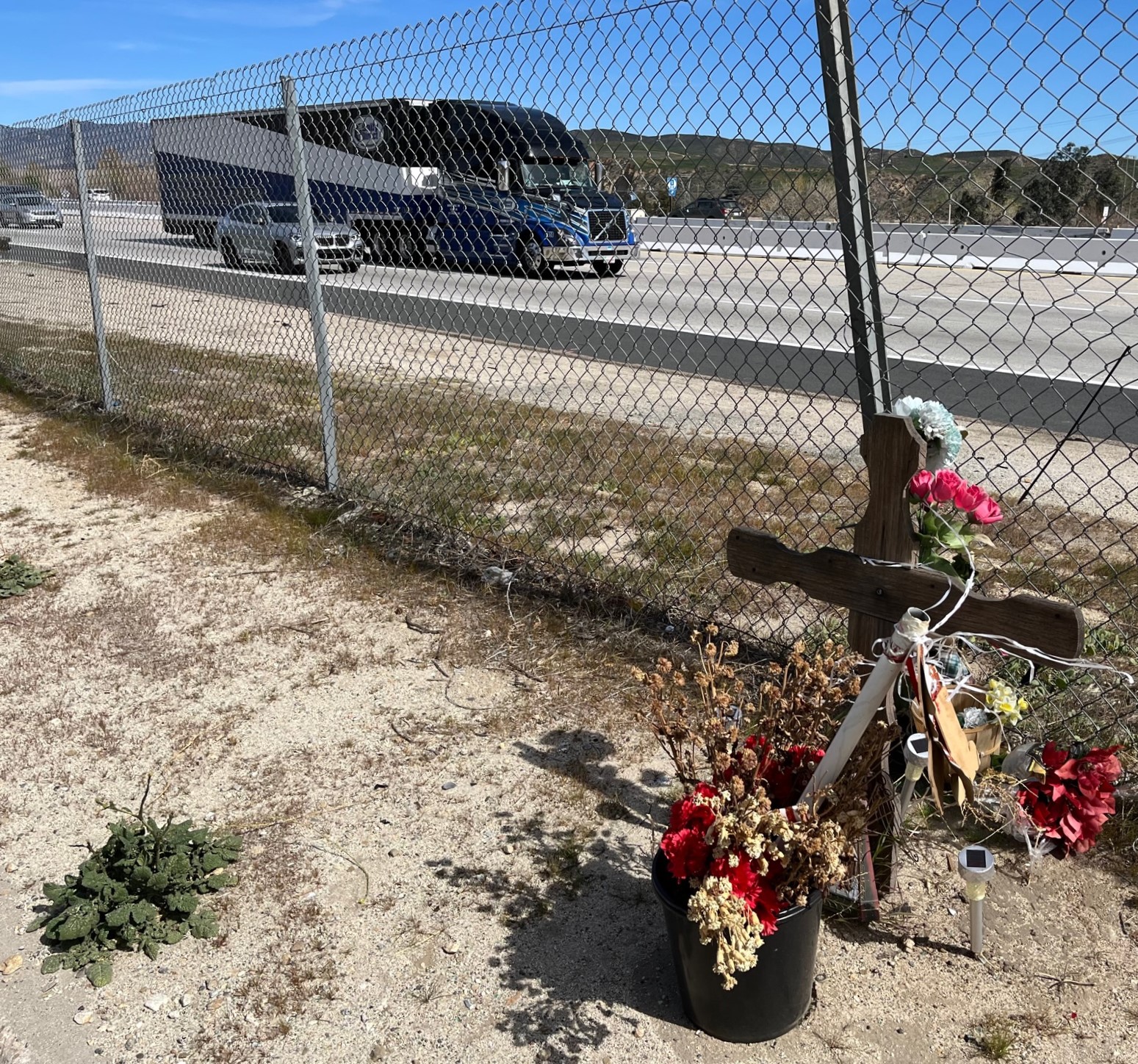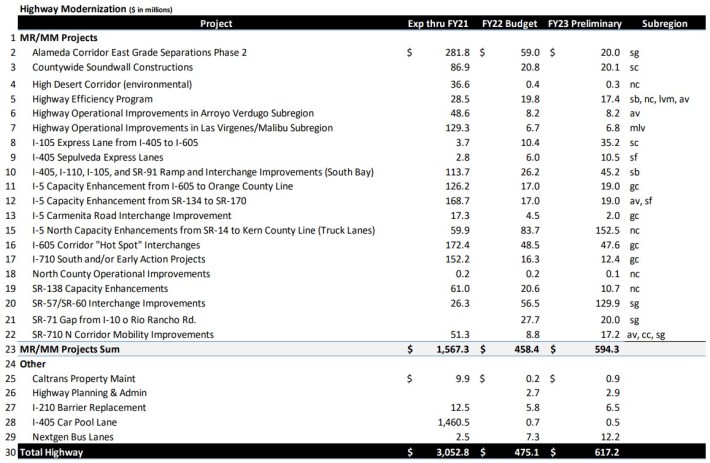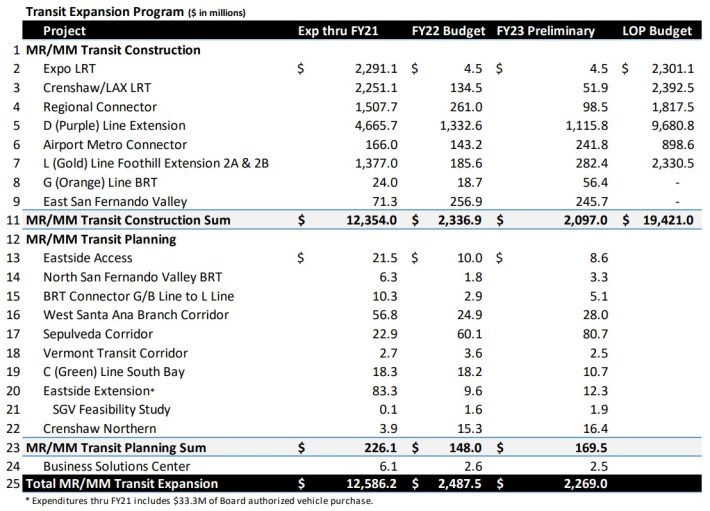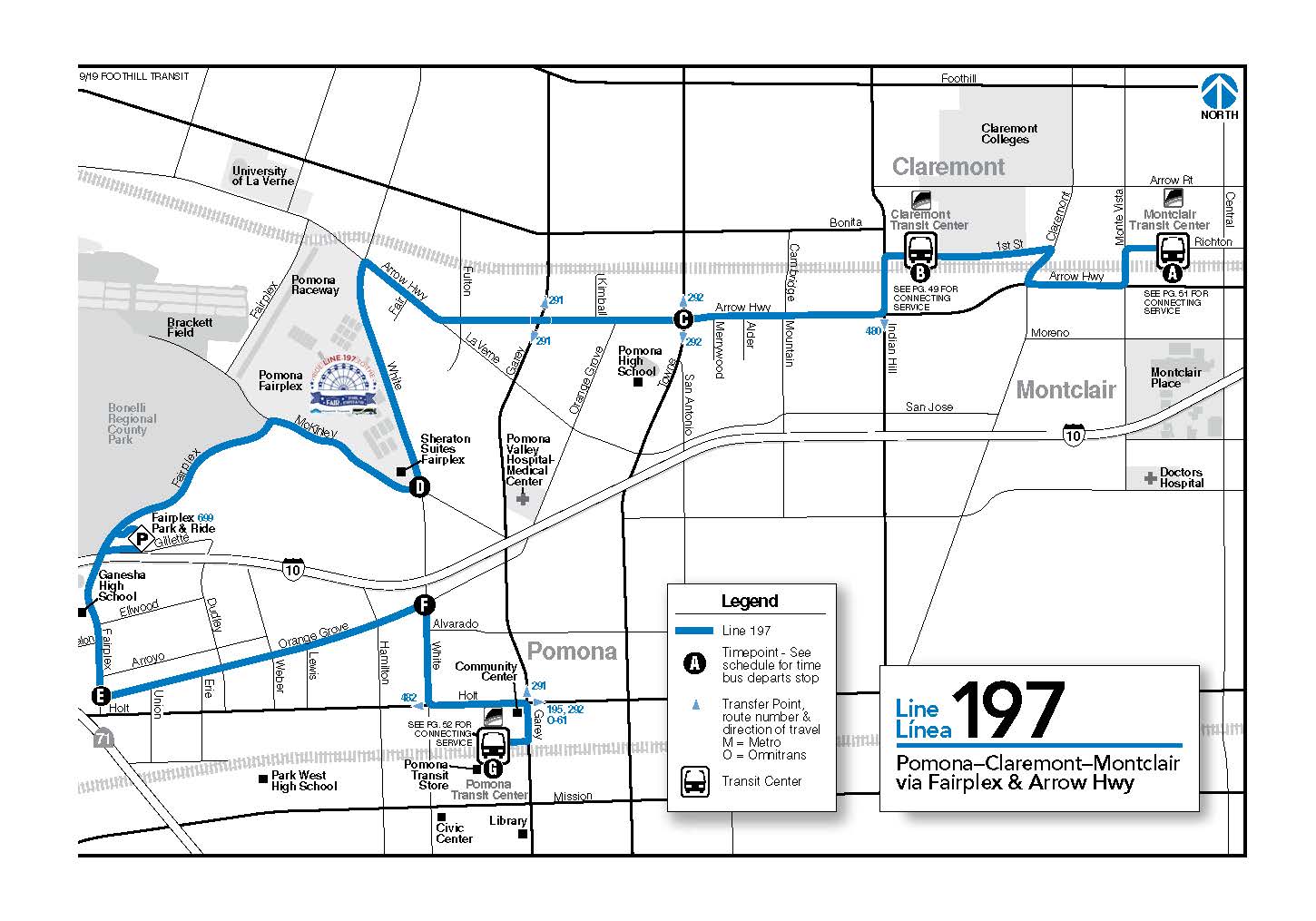Proposed Metro FY22-23 Budget: Increase Freeway Widening, Decrease Transit Construction
5:22 PM PDT on March 17, 2022

Metro is spending $679 million to widen the 5 Freeway through Santa Clarita. Photo by Joe Linton/Streetsblog L.A.
In a report to the Metro board Finance, Budget, and Audit Committee yesterday, Metro staff gave an early preview of the proposed budget for Metro's next fiscal year, which starts in July. In May, the board will vote on the roughly $8 billion overall FY22-23 budget. While the full budget figures are still in flux, the current proposal shows a 30 percent increase in freeway expansion and a 9 percent decrease in transit expansion.
(A note on language: Metro's budget wording is misleading. Metro's budgets and staff reports show two main capital categories: "Highway Modernization" and "Transit Expansion." There is nothing "modern" about Metro spending billions to widen freeways, so this Streetsblog post uses equivalent terminology for these categories: "Highway Expansion" and "Transit Expansion.")

This year's proposed 30 percent increase comes on top of an 80 percent increase in last year's Highway Expansion budget.
- FY20-21 (approved) $264 million
- FY21-22 (approved) $475.1 million - 80 percent increase from prior
- FY22-23 (proposed) $617.2 million - 30 percent increase from prior

Contrast this with Metro's proposed Transit Expansion (largely rail expansion - including planning and construction) budget which is slated to decrease next year.
- FY20-21 (approved) $2.15 billion
- FY21-22 (approved) $2.50 billion - 16 percent increase from prior
- FY22-23 (proposed) $2.27 billion - 9 percent decrease from prior
Though the two budget charts above include the big picture - Metro's capital costs for its mega-projects - they are not quite an apples-to-apples comparison. Below are a few caveats on the above figures:
- There are small discrepancies in approved budgets, revisions, and what gets spent. SBLA has used the most recent figures this editor could find, which can sometimes be slightly different than later-revised actuals, but the final amounts are within a couple percent of what is shown above. Find approved budgets at Metro budgets webpage.
- The overwhelming majority - more than 90 percent - of the FY22-23 proposed $617 million Highway Expansion budget would go to widening freeways, freeway ramps, and streets. There are a handful of miscellaneous items in the Highway Expansion budget that are not all about expanding car capacity. There are two projects that primarily benefit transit riders: new NextGen bus lanes ($12.2 million) and new barriers to keep 210 Freeway trucks from continuing to crash into the L Line ($6.5 million). There are two items intended to benefit both driving and non-driving modes: Alameda Corridor East rail grade separations ($20 million) and High Desert Multi-Purpose Corridor ($0.3 million). There are also very limited complete streets components in three predominantly car-centric items: 605 Freeway "hot spots" improvements (example), 710 Freeway widening early action projects, and 710 Freeway North mobility improvements. Those three total $77.2 million - less than a tenth of that is currently for non-car-capacity components. Overall, Streetsblog estimates conservatively that just ~7-8 percent ($46.7 million of $617 million) of the Highway Expansion budget is not specifically for increasing car capacity. (Note that Transit Expansion budget projects also include car-capacity components: park-and-ride, street widening, etc. Many expensive rail project grade separation features - tunnels, aerial tracks - are deemed necessary for rail to not impede car traffic.)
- The Transit Expansion budget is not the whole transit budget. It does not include operations, bus and rail fleets, maintenance, etc. The staff report [Appendix B] shows an additional $500.6 million Transit Improvements budget that is outside of the mega-projects budget above. Those separate Transit Improvements include a new operations center, J Line bus electrification, the Rail to Rail path, Rosa Parks Station upgrades, mobile validators, fare capping, and lots more. The proposed Transit Improvements budget would increase about two percent - from $491.2 million to $500.6 million.
- The Highway Expansion budget is not Metro's whole car-capacity budget. Some freeway project planning is separate. The Highway Expansion budget doesn't include pass-through Local Return funds that go to municipalities, which use them predominantly for car projects. It doesn't include some other Metro programs that support driving: freeway service patrol, etc.
So, why the big increase in the freeway widening budget?
Metro's staff report notes that the highway funding increase is "primarily due to construction activities for I-5 North Capacity Enhancements, SR-57/SR-60 confluence, and progression of I-105 ExpressLane to Project Specification and Engineering phase."
Indeed Metro's $679 million North County 5 Freeway widening accounts for a quarter of the proposed FY22-23 Highway Expansion budget: $152 million out of $617 million. That project is under construction (and partially state- and federally-funded), so its budget allocation won't change significantly.
But the proposed highway budget calls for several other freeway projects to be accelerated. Voters approved a Measure M schedule that has the $770+million 57/60 Freeway interchange expansion groundbreaking taking place in FY25. Why is Metro expending any local money to accelerate that? Measure M's schedule shows a 105 Freeway ExpressLane groundbreaking in 2027. Again, why move this up?
While freeway budgets keep increasing and freeway projects jump ahead of schedule, many Metro rail and bus projects are delayed (e.g. East San Fernando Valley light rail's FY21 groundbreaking hasn't happened, bus electrification pilots are a year-plus late, G Line upgrades, NextGen Transit First bus upgrades) and get split up into shorter segments (e.g. West Santa Ana Branch, Eastside L Line), in part due to the lack of capital funding. Metro also struggles to pay for first/last mile active transportation improvements, including the delayed Rail-to-River and L.A. River path projects.
And though there are fairly clear lines between capital and operations funding (and it's difficult to shift some freeway money to rail), this is all happening at a time Metro has repeatedly cut bus operations - first due to COVID, then - last month - due to a largely-self-inflicted operator shortage.
Metro's fiscal outlook is good. Recent sales tax revenues are higher than anticipated: $188 million in more than expected for the recent first quarter of FY22. During the same period, transit operations expenses were $106 million under budget. Metro has a great deal (apparently about a billion dollars) of unallocated federal COVID stimulus funding. Why cut transit capital funding now?
Metro's CEO Stephanie Wiggins has promised to make equity and climate among her top priorities. Wiggins directed the agency to apply the "equitable zero-based budget" (EZBB) process to capital investment [see slide 3]. This means that, instead of doing things the way Metro has always done them, staff are charged with starting from zero and determining a capital budget that advances equity - fairness toward communities of color and low income folks.
(Note that freeway building/widening is inequitable in multiple ways. Many of Metro's freeway projects - especially widening the 710, the 5, the 605, the 71 - demolish homes in communities of color. Even when they don't demolish homes, freeway projects are inequitable in that they provide mobility benefits only to households well-off enough to own cars, while polluting the air [damaging neighborhoods and climate], and worsening mobility for folks who get around by foot, transit, and bike.)
Metro's FY2022-23 budget is still being developed - and won't be finalized until it goes to board approval in May - so it's too soon to assume that Wiggins' bottom-up budgeting process has failed. But the preliminary results - increasing freeway capital expenditures while decreasing transit capital expenditures - are pretty alarming.
When the COVID pandemic hit, Metro essentially froze its highway expansion budget for months. Given the need to address the climate emergency, and longstanding freeway expansion equity issues still very much present today, Metro leaders - from its CEO to its board - need to rein in the excesses of freeway expansion programs and double down on greener modes. Board, be warned that last May, Metro staff - and then CEO Phil Washington - repeatedly made false statements in order to justify freeway budget increases.
Read More:
Stay in touch
Sign up for our free newsletter
More from Streetsblog Los Angeles
No, L.A. City Does Not Always Add Required ADA Ramps During Resurfacing, But They Should
StreetsLA GM Keith Mozee "Any time we do street resurfacing, it is considered an alteration, which requires ADA ramps to be installed."
LAPD Was Crossing Against Red Light in Crash that Killed Pedestrian and Injured Six in Hollywood
The department says the officers had turned on their lights and sirens just before crossing, but won't say why they did so.




